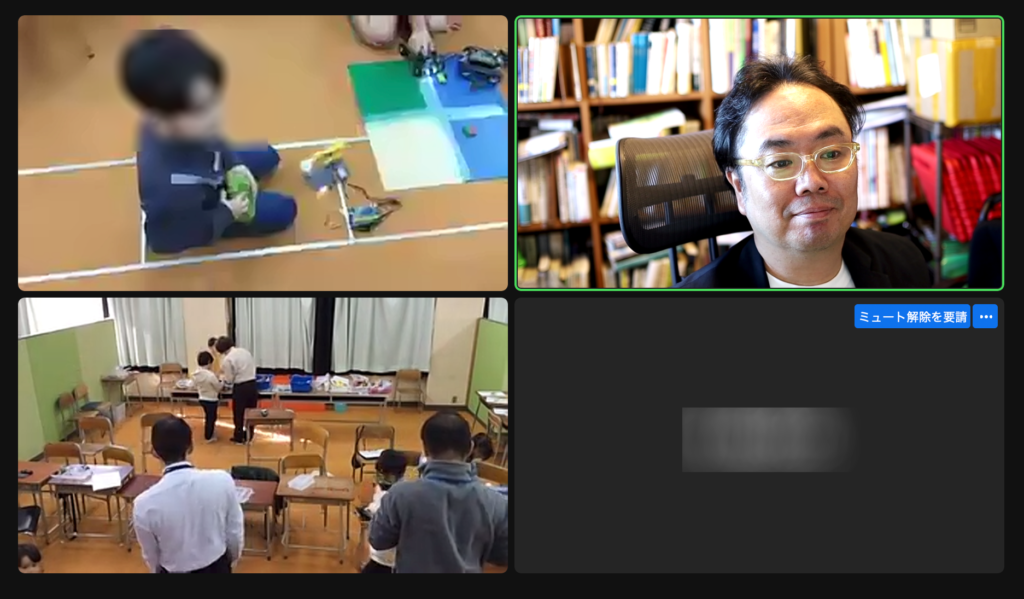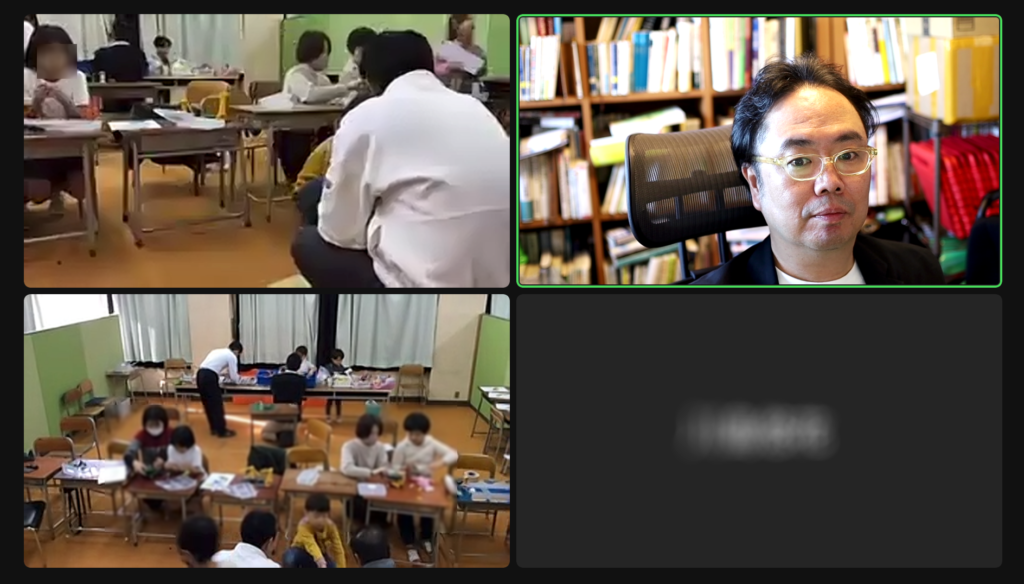
On December 7 and 8, we conducted remote classes (workshops) in a special needs classroom in Hachioji City. This time, the classes were held at a different elementary school from those held in September and November. 6 classes were held in total for grades 1 through 6. The content of the workshop was to create computer-activated works of art. The lower grades used a Programmable Battery, and the upper grades used a PICO Cricket, blocks, and craft materials to create works of their own interest in two 90-minute periods. For the first time, upper graders were given the opportunity to create their own works of art using the Programmable Battery in a single 45-minute session.
Each of these classes was an opportunity for the children to experience the tools for the first time. First, we showed them what kind of works they could create, showed them videos of works created by other children in the workshop, and briefly introduced how to use each tool. After that, we spent at least 60 minutes in two classes and at least 30 minutes in one class on creating artwork.
During breaks in the two classes, the teachers asked the students to take a break, but no one took a break and continued working. During the making time, each student is working on his/her own activities at his/her own pace and in his/her own time. Therefore, it may indeed be difficult to interrupt the work on someone else’s time (school time). This reminds us again of the importance of being on our own time. This may be true not only for children, but also for us adults.
What kind of time is “my time”? And what kind of state are we in when we are on our own time?
In order to make it our own time, we first need to make it an activity that is interesting to us and that we can be interested in. In the case of making things, it is important to create a work of art that interests you. At the beginning of each class or workshop, we introduce about 10 samples of the work by showing them on video or, in some cases, actual objects, in order to help students develop an image of the work. This is to give the children an idea of the kind of work they would like to create.
While some children continue to freely try out tools, select materials, and create their own works, others are left pondering what to create. Of course, it is important to spend time thinking without moving your hands, looking at the tools and materials, and watching the children around you. However, in a class or workshop where time is limited, it is important to ask, “Let’s see what kind of materials we can use. or “Why don’t you try out the program first? or “Why don’t you try the program first? Again, since time was limited, I printed out and prepared a module blueprint of the movement provided by Playful Invention Company, the developer of PICO Cricket. It is a module for changing the movement of a motor using blocks, and it shows how to make them in order. Some children find it easier to work with the blueprints first. However, every child will make his or her own modifications after following the blueprints. This is called remixing in Scratch, and it allows children to see the contents (program) of the shared work so that they can create their own work based on the work created by other children, The program also allows you to see the contents (program) of the shared work and modify it in your own way. Scratch also keeps a record of which works have been remixed and which have been created.
Very few (if any) of our ideas come from scratch. We take someone else’s idea and add something of our own to it to make it our own. Whether we are looking at a blueprint, using someone else’s work as a reference, or creating a work similar to our past work over and over again, there is always a new idea for that person, whether it is big or small (a little bit), including what we can see or not.

The educational learning theoretical background of the development and development of Scratch is constructionism of Papert et al. Constructionism combines construction (building) and knowledge construction, and introduces the importance of knowledge construction through building things. One of the most important words is “Personally Meaningful. This does not mean that any kind of manufacturing is acceptable, but emphasizes that knowledge is built through the creation of things that are meaningful to the individual and that can be of interest to the individual.
If we replace ideas with knowledge, we can say that this is our process of knowledge acquisition. Samples and blueprints are mere information, but we make our own knowledge by creating our own creations based on that information and, moreover, by combining the various information we have so far. In other words, making things may be the process of transforming knowledge from mere information to unique knowledge that is different for each individual. This may be exactly what we are returning to the idea of learning in Piaget’s constructivism, which is the basis of Papert’s idea of constructionism.
Knowledge as information is just information; it becomes inherent knowledge when it is combined with individual experience and pre-existing knowledge. Knowledge that we think is the same is never the same and varies from person to person. Conversely, if it is exactly the same, it is not knowledge, but information.
I would like to continue to conduct workshops and classes so that children can acquire the word “programming” as both a common piece of information and as different knowledge through workshops and class activities.
Returning to the topic of time, the state of being able to lose track of time and concentrate may mean that children are in the flow state that Csikszentmihalyi refers to. I would like to discuss this topic again in this blog through slow reflections on the workshop at another time.
Again, I have been thinking through the creation of this blog post about what I am learning and what kind of my own knowledge I am building through the activity of the remote workshop.
